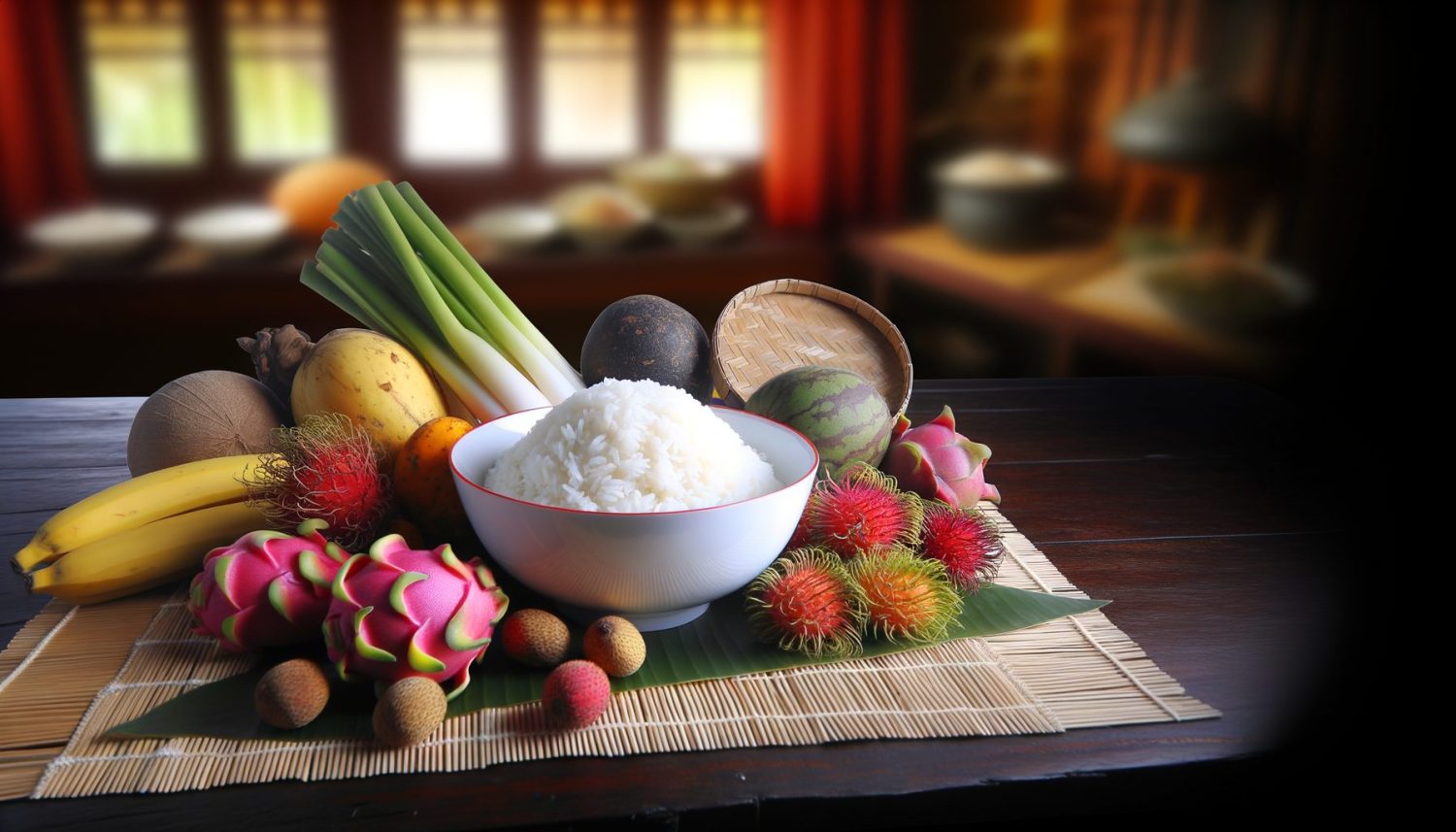Introduction to Far Eastern Nutritional Wisdom
The Philosophy of Food and Health in the Far East
The Far East is renowned for its unique approach to food and health, deeply rooted in a philosophy that sees eating as a form of medicine. The traditional perspective emphasizes the importance of consuming a balanced diet, which not only nourishes the body but also maintains harmony within the individual and the universe. This holistic view integrates the physical, spiritual, and emotional aspects of well-being, with food choices often reflecting a desire for longevity and vitality.
Understanding the Balance of Yin and Yang in Diet
Central to Far Eastern nutrition is the concept of Yin and Yang, two opposing yet complementary forces that are believed to exist in all aspects of life. Foods are categorized as Yin (cooling, moist, and passive) or Yang (warming, dry, and active), and the goal is to achieve a dietary balance that aligns with one’s individual constitution and the current season. For instance, consuming cooling Yin foods like cucumbers during the summer can help balance the body’s internal heat, while warming Yang foods like ginger in the winter can help to keep the body warm.
The Role of Traditional Medicine in Dietary Choices
Traditional medicine systems, such as Traditional Chinese Medicine (TCM) and Ayurveda, play a significant role in shaping dietary choices in the Far East. These systems offer dietary guidelines based on an individual’s health condition, body type, and environmental factors. Foods are selected for their healing properties and are often used in conjunction with herbal remedies to prevent and treat illness. For example, ginseng is commonly used for its restorative properties, while goji berries are prized for their ability to support eye health.
Overview of Common Far Eastern Dietary Practices
Common dietary practices in the Far East include the consumption of a variety of plant-based foods, whole grains, and fermented products. Meals are typically structured around rice or noodles, accompanied by an array of vegetables, lean proteins, and broths. Portion control is practiced, with an emphasis on small, frequent meals. Fermented foods such as kimchi and miso are staples, valued for their probiotic content and ability to aid digestion. Additionally, the practice of mindful eating is encouraged, with a focus on the sensory experience of food and gratitude for its sources.
Rice: The Staple Grain and Its Varieties
Nutritional Profile of Different Types of Rice
Rice is a fundamental component of the diet in many cultures, particularly in the Far East. It comes in various forms, each with its own nutritional benefits. White rice, the most commonly consumed type, has had the bran and germ removed, which strips it of fiber, vitamins, and minerals. Brown rice, on the other hand, is a whole grain that retains its bran and germ, making it richer in fiber and nutrients such as magnesium, phosphorus, and B vitamins. Other varieties, such as black rice and red rice, also offer unique health benefits, including high levels of antioxidants.
The Significance of Rice in Far Eastern Cultures
Rice is not just a staple food in the Far East; it is deeply ingrained in the cultural fabric of the region. It shapes the landscape through vast rice paddies, drives the economy, and is present in most meals. In Indonesia, for example, rice is central to the concept of a meal, with dishes like nasi goreng (fried rice) being national favorites. The importance of rice is also reflected in social customs and religious rituals, signifying prosperity and life itself.
Brown vs. White Rice: Health Implications
The debate between brown and white rice centers on their health implications. Brown rice is often touted as the healthier choice due to its nutrient density and high fiber content, which aids digestion and may help in managing blood sugar levels. White rice, while more refined, is sometimes enriched to replace some of the lost nutrients and is easier to digest, making it a better option for those with sensitive stomachs.
Innovative Ways to Incorporate Rice into a Healthy Diet
There are numerous ways to include rice in a healthy diet. Brown rice can be used as a base for stir-fries, salads, and bowls, adding a nutty flavor and satisfying texture. Rice can also be incorporated into vegetarian and vegan diets as a source of carbohydrates. Additionally, rice flour can be used as a gluten-free alternative for baking. Innovative dishes like rice-stuffed vegetables or rice-based pancakes offer creative ways to enjoy this versatile grain.
Purium Products that contain Brown Rice as a Supplement:
Soy and Tofu: Protein Powerhouses
Health Benefits of Soy and Tofu
Soybeans and their derivative products, such as tofu, are celebrated for their high-quality protein content, which is comparable to that found in meat. Rich in essential amino acids, they serve as excellent plant-based protein sources for vegetarians and vegans. Soy is also laden with other nutrients, including B vitamins, fiber, potassium, magnesium, and isoflavones. These compounds have been linked to a reduced risk of heart disease and may aid in bone health. Tofu, made from pressed soy milk, inherits these nutritional benefits and is versatile enough to be included in a variety of dishes.
Debunking Myths Around Soy Consumption
Despite its nutritional advantages, soy has been surrounded by misconceptions. One common myth is that soy can adversely affect thyroid function. However, research indicates that soy consumption does not cause thyroid issues in individuals with adequate iodine intake. Another concern is the presence of phytoestrogens, which are plant compounds that can mimic estrogen. While some fear that these could disrupt hormonal balance, studies have shown that moderate soy intake is safe and does not have feminizing effects on men, nor does it increase the risk of breast cancer in women. In fact, it may offer protective benefits against certain cancers.
Creative Tofu Recipes for the Western Palate
Integrating tofu into Western cuisine can be a delightful culinary adventure. Tofu’s mild flavor and adaptable texture make it an excellent meat substitute or addition to dishes. Grilled tofu steaks, marinated in a blend of Western herbs and spices, can provide a satisfying alternative to traditional meats. Tofu scramble, seasoned with turmeric and nutritional yeast, offers a protein-packed breakfast option. For a sweet treat, silken tofu can be the base for smoothies or mousses, providing a creamy texture without the dairy.
Soy and Hormonal Health: What You Need to Know
The relationship between soy and hormonal health has been a topic of extensive research. Isoflavones, found in soy, are phytoestrogens that can exert mild estrogenic effects. However, these effects are significantly weaker than the body’s own estrogen. Some studies suggest that soy consumption may be beneficial during menopause, helping to alleviate hot flashes and protect against osteoporosis. Additionally, there is evidence that soy does not harm reproductive health. It is important for consumers to consider the source of their soy products, opting for whole soy foods over highly processed options, to maximize health benefits.
Tea: More Than Just a Beverage
Different Types of Tea and Their Health Benefits
Tea, a cherished drink across the Far East, is revered not only for its comforting warmth and diverse flavors but also for its numerous health benefits. The main types of tea—green, black, white, oolong, and pu-erh—are all derived from the Camellia sinensis plant and differ in their processing methods. Green tea, minimally oxidized, is packed with antioxidants like catechins, which may help in reducing inflammation and improving heart health. Black tea, fully oxidized, is known for its robust flavor and may contribute to improved gut health and blood pressure regulation. White tea, the least processed, boasts high levels of antioxidants and may have anti-aging properties. Oolong tea, partially oxidized, strikes a balance between green and black tea and is often associated with weight management. Lastly, pu-erh tea, a fermented tea, is believed to aid in cholesterol reduction and digestion.
Green Tea: The Elixir of Youth
Among these, green tea stands out as the “Elixir of Youth” due to its high concentration of epigallocatechin gallate (EGCG), a potent antioxidant. Regular consumption of green tea has been linked to a lower risk of chronic diseases, including certain cancers, and it may also enhance brain function and fat metabolism. Its anti-inflammatory and antibacterial properties contribute to a healthier, more youthful complexion, making it a staple in both dietary and beauty regimens in the Far East.
How to Properly Brew and Consume Tea for Maximum Benefits
To fully harness the health benefits of tea, proper brewing is essential. For green tea, water temperature should be just below boiling (around 80-85°C) to avoid burning the delicate leaves, which can release a bitter taste. Steeping time should be between 2 to 3 minutes. For black and oolong teas, hotter water (around 90-100°C) and longer steeping times (3 to 5 minutes) are recommended. White and pu-erh teas often have specific brewing instructions, but generally, they require a gentle touch similar to green tea. Consuming tea in its pure form, without added sugars or milk, is the best way to enjoy its natural flavors and health properties.
Tea Rituals and Their Significance in Mindfulness Practices
Tea rituals in the Far East transcend mere consumption; they are a form of mindfulness practice. The ceremonial preparation and consumption of tea, particularly in traditions like the Japanese tea ceremony, encourage a focus on the present moment, fostering a sense of peace and tranquility. Engaging in these rituals allows individuals to connect with the environment, the tea, and the company they share, promoting a holistic approach to well-being that nourishes the mind, body, and spirit.
In conclusion, tea in the Far East is a cornerstone of both daily life and ceremonial practice, offering a wealth of health benefits and a pathway to mindfulness. Embracing the art of tea can lead to a more balanced and harmonious lifestyle, reflective of the ancient wisdom that has revered this remarkable beverage for centuries.
Exotic Fruits: A Bounty of Vitamins and Antioxidants
Rambutan, Lychee, and Dragon Fruit: Nutritional Powerhouses
The Far East is home to a cornucopia of exotic fruits that are not only delightful to the palate but also brimming with nutritional benefits. Rambutan, a fruit that resembles a sea urchin, is packed with vitamin C, fiber, and minerals like iron and potassium. Its juicy sweetness makes it a favorite among tropical fruits. Lychee, with its fragrant aroma and translucent flesh, offers an abundance of vitamin B, vitamin C, and phytonutrients that aid in fighting inflammation. Dragon fruit, also known as pitaya, stands out with its vibrant pink skin and speckled flesh. It is rich in antioxidants, fiber, and vitamin C, and is known for its ability to stabilize blood sugar levels.
Incorporating Exotic Fruits into Everyday Diet
Integrating these exotic fruits into a daily diet can be a refreshing and healthful change. Rambutan can be eaten fresh or added to fruit salads for a tropical twist. Lychee can be blended into smoothies or used as a topping for yogurt and oatmeal. Dragon fruit is versatile and can be sliced into salads, blended into a vibrant smoothie bowl, or simply enjoyed on its own. These fruits not only add a burst of flavor but also enhance the nutritional profile of everyday meals.
The Role of Exotic Fruits in Traditional Healing
In traditional Far Eastern healing practices, exotic fruits are more than just food; they are medicine. Rambutan seeds are believed to have anti-diabetic properties, while lychee is thought to improve digestion and boost immunity. Dragon fruit’s high antioxidant content makes it a natural choice for detoxification and anti-aging remedies. These fruits have been used for centuries in various forms, from fresh consumption to being incorporated into herbal teas and tinctures.
Seasonality and Sustainability of Far Eastern Fruits
Exotic fruits from the Far East, like many natural treasures, are subject to the rhythms of seasonality. Their availability often depends on the climate and region, making them highly anticipated delicacies. Sustainability is also a crucial consideration; as global demand for these fruits grows, it is essential to support farming practices that protect the environment and ensure the longevity of these species. Consumers can contribute by choosing fruits from sources that prioritize sustainable methods and by being mindful of the ecological footprint associated with importing these delicacies.
Herbs and Spices: The Secret Ingredients
Common Herbs and Spices Used in Far Eastern Cuisine
The Far East is renowned for its vibrant and aromatic culinary traditions, which owe much to the use of a variety of herbs and spices. Commonly used herbs include lemongrass, Thai basil, mint, and coriander, each contributing a distinct flavor profile to dishes. Spices such as ginger, turmeric, star anise, and cinnamon are also staples, infusing meals with warmth and depth. These ingredients are not only prized for their taste but also for their health-promoting properties.
Medicinal Properties of Far Eastern Herbs and Spices
Many herbs and spices used in the Far East are revered for their medicinal benefits. Ginger, for instance, is known for its anti-inflammatory effects and its ability to aid digestion. Turmeric contains curcumin, a compound with potent antioxidant properties. Star anise is a source of shikimic acid, which is used in the production of antiviral medications, and cinnamon is celebrated for its ability to regulate blood sugar levels. These ingredients have been used in traditional medicine for centuries and continue to be studied for their potential health benefits.
Incorporating Healing Spices into Western Cooking
Integrating Far Eastern spices into Western cuisine can be a delightful and healthful endeavor. Start by adding a pinch of ground ginger to smoothies or teas for a warming kick. Turmeric can be sprinkled over roasted vegetables or blended into soups for an anti-inflammatory boost. Cinnamon can be used in baking or to spice up your morning oatmeal. Experimenting with these spices not only enhances flavor but also incorporates the healing properties of Far Eastern cuisine into everyday meals.
The Impact of Spices on Digestion and Metabolism
Far Eastern spices are not only flavorful but also beneficial for digestion and metabolism. Spices like ginger and turmeric stimulate digestive enzymes, which can help improve the absorption of nutrients. Cinnamon has been shown to have a regulatory effect on metabolism, particularly in the management of blood sugar levels. Incorporating these spices into meals can support a healthy digestive system and metabolic function, contributing to overall well-being.
In conclusion, the herbs and spices of the Far East are integral to the region’s culinary identity and have profound health benefits. By embracing these ingredients, we can enrich our diets with flavors that tantalize the palate while nurturing the body.
Conclusion: Embracing Far Eastern Nutritional Practices
Adapting Far Eastern Foods for the Western Diet
The Far East offers a cornucopia of nutritional treasures that can enrich the Western diet. Adapting these foods to Western tables involves understanding their health benefits and learning how to integrate them into everyday meals. For instance, incorporating fermented soy products like miso and tempeh can provide probiotics and plant-based protein. Swapping out processed snacks for exotic fruits such as rambutan or lychee can offer a sweet treat while boosting antioxidant intake. Additionally, using whole grains like brown rice instead of refined grains can enhance fiber consumption and improve satiety.
The Future of Global Nutrition: Learning from the Far East
As the world becomes increasingly interconnected, the fusion of culinary traditions offers a pathway to a healthier global diet. The Far East’s emphasis on balance, variety, and moderation aligns with contemporary nutritional guidelines and can combat lifestyle diseases. Embracing practices such as mindful eating and the consumption of a diverse range of plant-based foods can lead to more sustainable and healthful eating habits worldwide.
Simple Steps to Incorporate Far Eastern Wisdom into Daily Life
- Start with small changes: Add a side of kimchi for probiotics or replace sugary beverages with green tea.
- Explore seasonal produce: Enjoy fruits and vegetables that are fresh and at their nutritional peak.
- Practice mindful eating: Take time to savor your food, paying attention to the flavors and textures, and listen to your body’s hunger cues.
- Learn to cook a few simple Far Eastern dishes: This can make the incorporation of these foods into your diet more enjoyable and sustainable.
Final Thoughts on a Balanced and Mindful Approach to Eating
Ultimately, the nutritional wisdom of the Far East is not just about the foods consumed but also about the approach to eating. A balanced diet, rich in whole grains, lean proteins, and vibrant fruits and vegetables, is complemented by a mindful attitude towards consumption. By taking the time to appreciate the flavors and origins of our food, we can foster a deeper connection to our meals and to the cultures they come from. Embracing the Far Eastern philosophy of harmony in our diets can lead to a more fulfilling and healthful way of life.
READ MORE: Top 8 Benefits of Organic Brown Rice Protein
Sources:
https://www.nccih.nih.gov/health/traditional-chinese-medicine-what-you-need-to-know
https://www.medicinenet.com/egcg_epigallocatechin_gallate_benefits_dosage/article.htm
https://www.healthline.com/nutrition/rambutan









